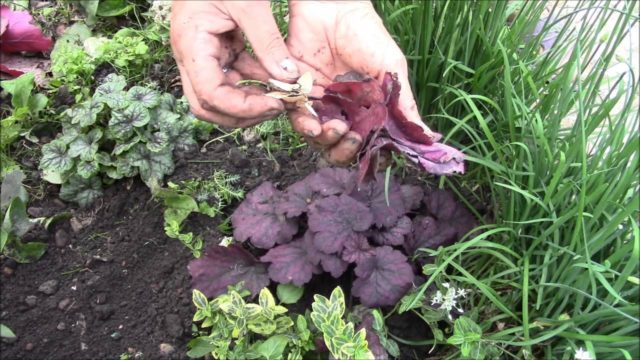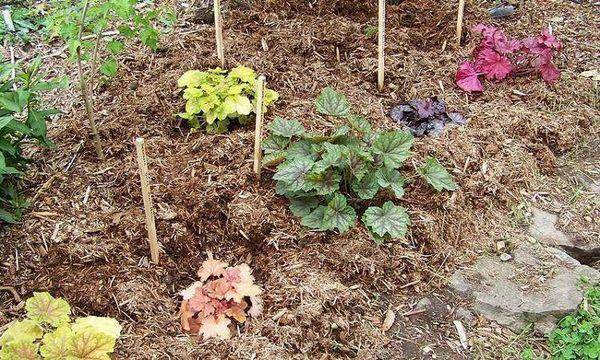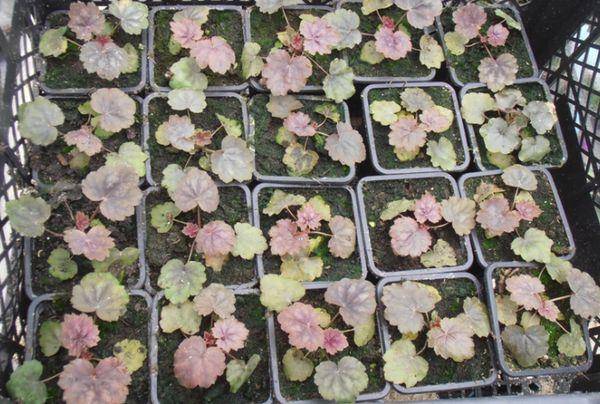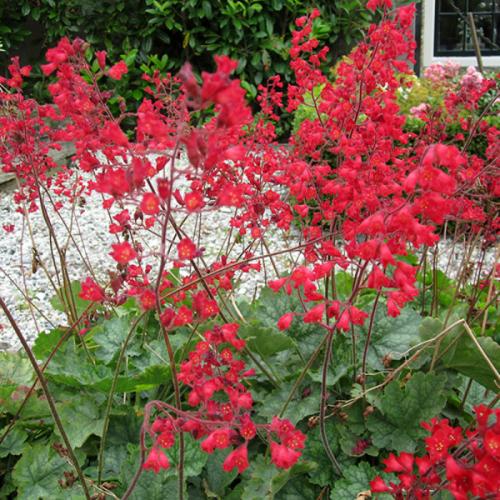Planting and caring for blood-red Heuchera outdoors

Winter-hardy, unpretentious to growing conditions, the culture feels great in the southern, central regions of the country. But it can also be successfully grown in Siberia, covering it from frost for the winter. Every 4 - 5 years, the bushes require rejuvenation with division of the rhizome and transplantation, due to the rapid growth rates. Caring for blood-red Heuchera is not difficult - it is undemanding to abundant watering and fertilizing
Periodically, it is important to loosen the soil, followed by mulching with bark or peat. It is necessary to mulch before wintering.
When growing unpretentious blood-red heuchera, problems can still arise:
- lodging or breaking of long peduncles during the wind, which indicates that it is better to pick up a place protected from winds and drafts;
- the growth of the base above the soil level indicates the obligatory annual hilling of the plant;
- rot of the root system due to waterlogging of the soil.
It is worth saying that in a dry summer without watering Heuchera, the bloody one will suffer from a lack of moisture. Therefore, the event must be organized correctly.

Landing site preparation
The place for the blood-red geychera should be light, with a light, delicate shade in the sultry midday hours. It is better to plant the plant on the east or west side of the infield. The culture prefers loose, neutral soil with low acidity. Before planting in acidic soil, add chalk, lime, dolomite flour or wood ash. The soil can be mixed with mineral fertilizers and compost.
Important! Heuchera should not be planted in a shady place, where it will lose its special attractiveness and richly bright colors.
Landing rules
At the bottom of the planting pits with a diameter of 30x30, a drainage layer of river sand and fine expanded clay must be laid. Next, the prepared fertile soil is poured and the rhizomes of blood-red heuchera are buried until the beginning of the leaf rosette. Fertile soil is added from above, lightly tamped and watered.
Watering and feeding
Geichera prefers dry, not waterlogged places and can even withstand a short drought. Water it no more than once a week, preventing waterlogging and stagnant water. Otherwise, the root system of the plant will start to rot.
Top dressing of blood-red Heuchera is reduced to a rare application of mineral fertilizers. The dose usual for other horticultural crops is reduced by 2 times, since overfeeding the plant will lead to the development of diseases. In the first years of life, it takes all the substances necessary for growth and development from the soil.
Important! Heuchera of any grades and types does not need organic feeding. They can provoke rotting of the root system.
Pruning
In the spring, wilted and dried leaves are removed. In the fall, pruning is not recommended, since the updated Heuchera is unlikely to be able to successfully overwinter. After pruning, the soil is spud and mulched with a mixture of peat, humus and river sand.
Preparing for winter
The plant does not need shelter for the winter in the southern and central regions. But young seedlings, as well as adult bushes, in especially harsh winters or in Siberia, can freeze slightly. To avoid this, the bushes are covered with spruce branches or fallen leaves.
Important! Before wintering, it is not necessary to remove the ground part of the bush, since the leaves will serve as additional shelter for growth buds. A video about caring for Heychera will give even more useful information:
A video about caring for Heychera will give even more useful information:
Growing Heuchera from seeds
Sowing Heuchera for seedlings
Heuchera reproduces well by seed, but the viability of its seed remains no more than six months, so when buying, check the packaging date. In foil bags, seeds are stored longer - up to one and a half years. It is not necessary to stratify seeds before sowing.
Heuchera seeds are sown in a wide box or container at least 5 cm high with drainage holes so that excess water flows freely into the pan without stagnating in the roots of the seedlings. Heuchera soil should be loose, moisture and breathable. You can buy a substrate for seedlings in a garden pavilion, dilute it by a third with perlite or sand, mix thoroughly, and then warm it up for 5-7 minutes in a microwave oven for disinfection. And you can sterilize the substrate by spilling it with boiling water or potassium permanganate solution. The soil is prepared two weeks before sowing, so that during this time useful microflora can recover in it.
Sowing is carried out in March or April, after mixing very small heuchera seeds with sand, so that it is easier to evenly distribute them over the surface of the moist, loosened and leveled substrate. The seeds are not buried, but simply pressed slightly against the ground, after which the crops are covered with foil or glass and placed in the brightest place in the apartment, creating protection for them from direct sunlight and drafts. Contain crops at a temperature of 20-22 ºC. In such conditions, seedlings may appear in 2-4 weeks, although sometimes more time may pass: heuchera from seeds germinates and develops slowly, but you should not worry about this.
Care of Heuchera seedlings
Crops must be aired daily, leaving them uncovered for half an hour. As soon as the first shoots begin to appear, make holes in the film for air access, but do not remove it. If you covered the crops with glass, move it slightly so that the seedlings can breathe through the gap. The cover can be removed when massive seed germination begins.
At the stage of development of three true leaves, Heuchera seedlings dive in separate cups or into a common container, but observing a step of 4-6 cm between them.Maintain the substrate in a slightly moist state, but do not allow it to become waterlogged
After watering, gently loosen the substrate around the seedlings
Cariopteris care
Older specimens are able to withstand short-term drought without irrigation, while young seedlings must be maintained with moderate watering. Despite the drought resistance, the plantations during the flowering period need periodic irrigation with a small amount of water.

Karyopteris in garden design
In the spring, top dressing from compost or wood ash, which is added dropwise around the plant, works well. Too much fertilizer stimulates the growth of green mass to the detriment of flowering. This is only justified in the case of variegated varieties.
In autumn, the bush is spud with a thick layer of earth or fallen leaves, covered with agrofibre and additionally with coniferous branches.
The nutlet requires annual pruning of last year's shoots. In the spring, at the turn of March and April, when the risk of freezing is low, the bush should be pruned to a place where living tissue is preserved.
If the shoots are not frozen in warm winter, then they are shortened by half, damaged branches are removed, and thinned a little.
The subtleties of growing a plant
The cultivation of decorative heuchera has no special requirements, but there are a number of nuances that will help to get the maximum aesthetic pleasure from the plant:
- Peduncles of decorative deciduous varieties are removed immediately after their appearance, and in flowering varieties - before the formation of fruits.
- Young, fragile leaves must be protected from physical damage.
- Periodically, the flower needs to be transplanted into a hole deeper to prevent the appearance of friability of the bush.
- You can plant a culture in conjunction with decorative cereals, primroses, incense and daylilies.
Landing time and place
The right time for planting Heuchera is spring, starting in the second half of March. You can plant bushes in April if the ground is not warmed up enough. As for growing from seeds, you should be guided by the information on planting dates from the manufacturer. In the fall, the plant is not transplanted, but you can prepare cuttings and leave them indoors for the winter.

Most Heuchera varieties prefer partial shade, but there are some that become more attractive in direct sunlight. It is preferable to plant plants on the east or west side of the site.
Plant soil
The morphological composition of the soil is not an essential criterion, but like most grasses, Heuchera prefers loose, fertile soil. The plant does not tolerate acidic soil well, acidity is allowed in the range of 5-6 pH, which corresponds to neutral indicators.
Acidified soil can be corrected by adding wood ash, dolomite flour, or chalk.
Heuchera grows best in conditions of good air permeability so that oxygen can easily pass through the soil. It needs a lot of moisture, which does not stagnate at the roots, therefore it is necessary to provide a drainage device. For this, expanded clay, clay chips and small pebbles are well suited.
Preparation of planting material
Heuchera can be grown from seeds or seedlings, the preparation of planting material depends on this:
- The rhizome of the seedlings obtained by dividing the bush is washed, and the cuttings are sprinkled with ash and treated with a preparation for root growth.
- The seedlings purchased in the store are examined in search of damage or signs of illness, they must be planted immediately after purchase.
- Before planting, the seeds are soaked for 2-3 hours in water for several hours, then they are allowed to dry out, and before sowing, mix with river sand. Usually, cultivation of heuchera from seeds of their own collection is not practiced at home.

Planting process
Landing technology open ground geychers is simple and includes several stages:
- Preparation of planting holes with a diameter of 0.3 m and a depth of the same size.
- The distance between the bushes should be about 30 cm.
- The seedlings are lowered into the pit by transferring them from a container.
- The hole is filled with earth, lightly tamped.
- Each plant is watered abundantly at the root.
- Mulch the soil around the geychera with crushed peat, hay or sawdust.
Features of growing heuchera
The most favorable conditions for growing heuchera
Heucheras are undemanding to soils. Normal, lightweight, well-drained garden soil will do. Avoid heavy, with an excess of organic matter, waterlogged soils. The best place: the eastern part of the garden, where the sun is only in the morning. Heucheras grow in lace shade, under the crowns of trees and bushes. Open sun should be avoided.
Dates of planting heuchera rhizomes in open ground
Heuchera rhizomes can be planted both in spring and autumn. The timing of spring planting - after the ground warms up to +10 ⁰ С, autumn planting - until about the end of October.
Preparation of Heuchera rhizomes for planting
Heuchera rhizomes do not need special preparation. To improve rooting, before planting, you can hold the rhizomes for several hours in a solution of the Rootitel preparation.
Planting Heuchera rhizomes in open ground or flowerpots
Prepare a place for planting - 30 cm by 30 cm by 30 cm, apply a universal soil mixture. Do not deepen the horse neck. After planting, slightly spud the plant. Distance between plants when planting: 30 - 40 cm.
Geycher care
Heucheras are unpretentious. Water the plants in moderation, avoiding stagnant water. Once a season - huddle the plants, because their neck grows over time above the soil level. Every three to five years, in the spring, before flowering begins (usually in May), overgrown heucheras should be planted, dividing the bush into several parts. It is good to mulch the Heuchera plantings, this will relieve them of overheating and drying out of the soil in the summer, and will protect them in the winter.After the end of flowering, it is better to cut the peduncle so that the plant does not waste energy on ripening the seeds. In autumn, the aerial part of the plant partially dies off, some varieties retain their leaves under the snow. Geykhera practically do not get sick, but for the prevention of diseases - you can use the ready-made drug Dr. Foley for diseases.
Heuchera shelter for the winter
Geykhera are frost-hardy and hibernate without shelter. But, as it grows, the root collar of the heuchera is located closer and closer to the soil surface. Therefore, in the fall, heucheras are slightly huddled and sprinkled with fallen leaves in case of a snowless and cold winter.
Heuchera feeding
Geichera grows in nature on very lean soils, so one top dressing per season will be enough for her. In the spring, you need to feed the geykhera with a complex mineral fertilizer, with a predominance of nitrogen. Take the concentration half as much as instructed. It is better to underfeed geykhera than overfeed. It will be convenient for you to use a complex preparation - Gilea Vegetation.
Features of using Heuchera, useful and interesting information
Geykhera are a favorite plant of landscape designers. Heucheras are indispensable in shady gardens, rockeries and rock gardens. Geykhera are good both in group and single plantings. They look great in near-trunk zones, in mixborders, rabatkas, borders, as well as a foreground plant. Perfect companions for geychera - hosta, astilba, bruner, badan, aquilegia. It is good to plant geykhera in the foreground in front of spireas, weigels.
accepting orders for Heuchera until September 29; distribution of orders on May 21 - October 5 *
* New varieties of Heuchera 2018 introductions will be planted in p9 containers in the spring of 2018 and will be distributed in Moscow (sent by mail) from September. The exact dates of delivery of the variety are indicated on the page with its description.
how to buy heuchera in the online store
| 1 select parse | 2 fill in the number |
| planting material geyhera Collector's page «> cont.p9 250 rubles | Quantity: |
| container p11 Collector's page «> cont p11 450 rubles | 3 click the trash can button |
The name of the parsing leads to a photo of the Heuchera planting material and the background color: order forecast
If you made the purchase correctly, a copy of the order will be sent to you by e.mail and the order will appear in the "My Data" section. Before buying, read the rules for selling geyhera in moscow and buying by mail.
Sale of geykhera is carried out under the order - we do not have a warehouse where you can drive up and buy geykhera on the spot
Geykhera blood-red planting and care in the open field. Geichera blood red: varieties, planting and care
Heuchera blood-red is one of the perennial plants from the Saxifrage family. Its main advantage is its excellent decorative properties. The height of the Heuchera rosette can reach 25 cm. The stems, on which large bright flowers are located, grow up to 50 cm in height. The color of the buds can be varied: from red, burgundy and pink to red and purple.
Brief description of culture
The culture is native to the southern United States and northern Mexico. Despite the subtropical climate habitual for this flower, Heuchera feels great in the regions of Central Russia. The only thing that affects it badly is the dry conditions of the hot summer.
Duration of flowering is 2-3 months (from July to August), and the decorative properties of Heuchera are preserved until autumn. The species is cold-resistant (tolerates very low temperatures down to -40 ° C) and unpretentiousness. The bushes of this culture grow very quickly, so they need to be replanted every 5 years.

Blood Red Heuchera
Blood-red Heuchera: varieties
Among the most famous varieties of blood red heuchera, the following are distinguished:
- Robusta. The main characteristic is the presence of large red flowers. In autumn, the leaves of the plant become burgundy. The flowering period is June-July.
- Gracillima. Heuchera of this variety reaches a height of half a meter.The flowers are pink in color and are collected in dense, graceful buds.
- Rakete. This variety is represented by geychera up to 70 cm high. They are distinguished by late flowering. The buds are red.
- Splendens. The stems grow up to 50 cm in height. It is a carmine-red Heuchera that blooms in July-August.
- Geicher Snowstorm. The maximum height of the peduncles is 35 cm. The foliage has a variegated color, the flowers are bright red. The variety is very delicate and whimsical, without shelter, it is not able to tolerate frost. Flowering begins in May and ends in July.
- Bressingham Bronze (Bressingham Hybrids). The plant reaches a height of 60 cm. Flowers can be pink, red or white. Flowering occurs in mid-summer - early autumn.
- Alba. The flowers are white in color, collected in lush inflorescences.
Heichera Alba
- Heuchera Heuchera Starburst (Staburst). Green leaves are brown in color. The variety tolerates cold well.
- Geichera Purple Castle. The color of the leaves is varied. Due to this, heuchera purple has a great decorative value.
- Heuchera blood-red Heuchera Sanguinea Coral Forest (Coral Forest). Differs in long, bright flowering. The color of flowers in Heuchera Coral Forest fully corresponds to the name - it is coral.
- Heuchera is red-leaved. The height of the stems is 40-50 cm. The red-leaved variety blooms in June-August.


